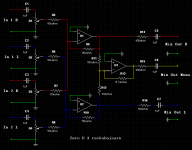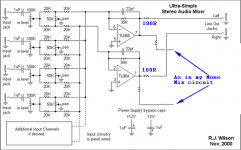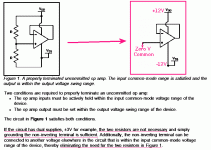Hey guys!
As a part of a small endeavor in the DIY jungle, I'm in need of help when it comes to a schematic of a simple mixer I've found over at musicfromouterspace.com. The schematics looks like this:
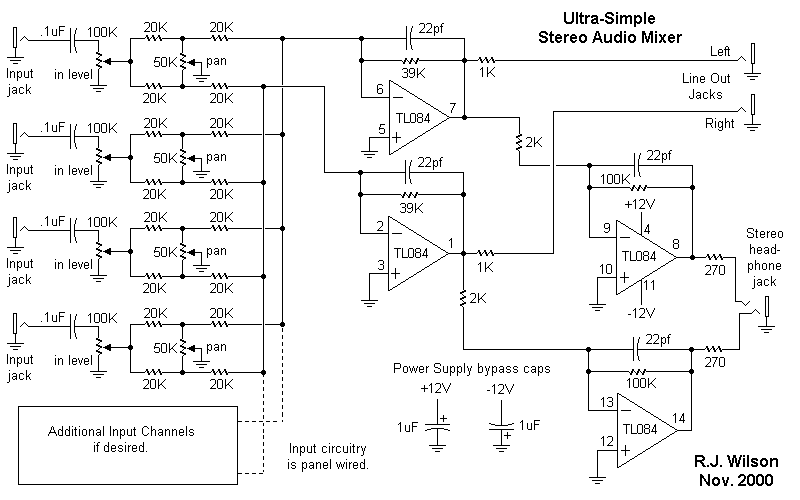
And I guess I've got a couple of questions.
1. Should I use Log or lin pots for the level? I've ordered both, since I realized that I probably want log ones after I've already ordered linear.. I know it's normally log pots for audio circuits, but I'm uncertain about the effect of the IC.
2. In this circuit, one of the outputs is meant for headphones, but I will use this as line out to record the mix. How do I connect a pot to adjust the level, and what resistance should it be?
3. Also, this part of the circuit is different from the line-level part. How would I modify it to be the same level as the "line-out" part? What I'm uncertain about is what to do with the 1K/2K resistors after the first op-amps. And should i change the value from 100K to 39k over the second op-amps, and remove the 270 Ohm resistors?
4. I will use one of the outputs to feed my amp (active speaker), so I really only need mono for that output. Is there an elegant way to sum the two signals again? I've found this circuit, but it might be unnecessary?
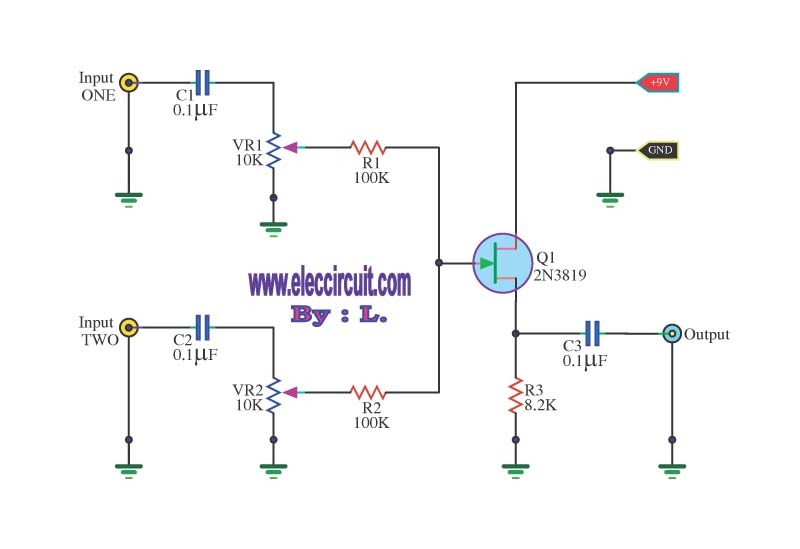
Any help is greatly appreciated, been waiting a good while for all components and stuff, so I just want to get started
As a part of a small endeavor in the DIY jungle, I'm in need of help when it comes to a schematic of a simple mixer I've found over at musicfromouterspace.com. The schematics looks like this:

And I guess I've got a couple of questions.
1. Should I use Log or lin pots for the level? I've ordered both, since I realized that I probably want log ones after I've already ordered linear.. I know it's normally log pots for audio circuits, but I'm uncertain about the effect of the IC.
2. In this circuit, one of the outputs is meant for headphones, but I will use this as line out to record the mix. How do I connect a pot to adjust the level, and what resistance should it be?
3. Also, this part of the circuit is different from the line-level part. How would I modify it to be the same level as the "line-out" part? What I'm uncertain about is what to do with the 1K/2K resistors after the first op-amps. And should i change the value from 100K to 39k over the second op-amps, and remove the 270 Ohm resistors?
4. I will use one of the outputs to feed my amp (active speaker), so I really only need mono for that output. Is there an elegant way to sum the two signals again? I've found this circuit, but it might be unnecessary?

Any help is greatly appreciated, been waiting a good while for all components and stuff, so I just want to get started
Should I use Log or lin pots for the level?
It's quite possible that linear pots are intended here, as they are 100k and will have a taper
that is set by the loading of the (much smaller) input resistor following them.
Last edited:
this part of the circuit is different from the line-level part.
How would I modify it to be the same level as the "line-out" part?
The simplest way is to change the two 2k input resistors to 100k each.
This would make the gain of that stage 0dB (x -1).
Last edited:
In this circuit, one of the outputs is meant for headphones, but I will use this
as line out to record the mix.
It would be best to use the outputs labeled "line out" for recording.
Then you can use the input pots for setting the gain/output level, as intended.
Then you would use the headphone outputs for monitoring. For one mono output only,
use just one op amp, with both input resistors going to the same inverting input.
You can have a 10k level adjust pot at the output of this op amp.
Last edited:
Hi,
1 - You don't say how many stereo inputs you need ?
2 - Do you actually need the L/R panning ?
3 - The design shows single Pots for the L & R inputs. Is this what you want, or Dual ones ?
4 - The design shows TL084's, but you want change to TL074's ? If so that's ok.
Here's what i would do in my image. All pots are 10k, Lin should be ok due to loading resistances. They could be single or dual. See if you can return the pots you bought. Caps are non polar types.
1 - You don't say how many stereo inputs you need ?
2 - Do you actually need the L/R panning ?
3 - The design shows single Pots for the L & R inputs. Is this what you want, or Dual ones ?
4 - The design shows TL084's, but you want change to TL074's ? If so that's ok.
Here's what i would do in my image. All pots are 10k, Lin should be ok due to loading resistances. They could be single or dual. See if you can return the pots you bought. Caps are non polar types.
Attachments
Thanks for the feedback!
@ZeroD It's actually mono inputs all of them, 8 inputs. I would like to be able to pan them for recording purposes. The mixer is a part of a portable "jamming suitcase" with an active speaker built in to it. I'll have several small mono synths connected to it.
Yeah, I read that the 074's have better noise handling, have both so I'll try out them both and see the difference.
@rayma Great tips, thank you. The main usage is the monitoring part, secondary is the recording. So I would like to use the input pots as "gain" level for the amp, but I'm not sure if the level to the line out will be good, so I'd rather have the possibility to adjust that. Should I still have 100k instead of the 2k? Maybe its better to have some gain there and be able to adjust the level with a pot? (not sure if I have it right here)
@ZeroD It's actually mono inputs all of them, 8 inputs. I would like to be able to pan them for recording purposes. The mixer is a part of a portable "jamming suitcase" with an active speaker built in to it. I'll have several small mono synths connected to it.
Yeah, I read that the 074's have better noise handling, have both so I'll try out them both and see the difference.
@rayma Great tips, thank you. The main usage is the monitoring part, secondary is the recording. So I would like to use the input pots as "gain" level for the amp, but I'm not sure if the level to the line out will be good, so I'd rather have the possibility to adjust that. Should I still have 100k instead of the 2k? Maybe its better to have some gain there and be able to adjust the level with a pot? (not sure if I have it right here)
So, trying to understand the circuit better: when summing the two signals, how does the resistance affect the signal? In the original there is 1k, in Zero D's suggestion they're 10k (R11&R12). And I guess he calculated the parallel resistance for the 5.1k feedback resistor(?)
And also, is there anything more general to be said about the resistors in an audio circuit? When looking at different schematics I found, it seems the values are high and low..
And also, is there anything more general to be said about the resistors in an audio circuit? When looking at different schematics I found, it seems the values are high and low..
If you had explained ALL your wishes originally, it would have saved us time etc !
As you want 8 inputs, keep the main mixer circuit as is. Replace the headphone part with my Mono Mix circuit.
Yes, TL074's are better for noise than the 84's.
R11 & R12 mix together 2 x voltages, both L & R = twice the voltage. So you need half the gain to remain at the same level as the Main mix outputs. So R13 is approx half of either R11/12. Approx because 5k's don't exist. You won't notice the difference !
As you want 8 inputs, keep the main mixer circuit as is. Replace the headphone part with my Mono Mix circuit.
Yes, TL074's are better for noise than the 84's.
R11 & R12 mix together 2 x voltages, both L & R = twice the voltage. So you need half the gain to remain at the same level as the Main mix outputs. So R13 is approx half of either R11/12. Approx because 5k's don't exist. You won't notice the difference !
Attachments
Sorry I wasn't more clear from the beginning Zero D! I think I've got the hang of it now, didn't think about the addition of the two signals as increase in voltage first. I don't know why I'm having such a hard time understanding audio circuits. I'm used to calculating electric circuits, but there it's fixed frequencies and no IC's and stuff, so that makes me uncertain.. Big thanks for the help to both of you, I'll probably need some more help later on other parts of the PortaJam
Hi again, one more thing i was wondering about.
With the new schematic, I have an unused opamp. It's not supposed to be left floating right?
And on that note, the line outs will not always be in use. I have the kind of TS connectors where the tip connector touches another connector as long as there is no plug insterted..
With the new schematic, I have an unused opamp. It's not supposed to be left floating right?
And on that note, the line outs will not always be in use. I have the kind of TS connectors where the tip connector touches another connector as long as there is no plug insterted..
> unused opamp. It's not supposed to be left floating right?
It will sing 13MHz and make trouble.
Tie "+ In" to audio common. Tie "Out" to "- In" with a jumper or small resistor. It will obediently follow "silence".
> line outs will not always be in use
Half the wall outlets in my house are not in use. I had a friend put tape over then "so the electrons don't fall out". This does not happen. I've had dozens of empty line outs when using a large console for a small act.
It will sing 13MHz and make trouble.
Tie "+ In" to audio common. Tie "Out" to "- In" with a jumper or small resistor. It will obediently follow "silence".
> line outs will not always be in use
Half the wall outlets in my house are not in use. I had a friend put tape over then "so the electrons don't fall out". This does not happen. I've had dozens of empty line outs when using a large console for a small act.
http://pdfserv.maximintegrated.com/en/an/AN1957.pdf
What about the text in figure 3D? That's how you meant right? Would it be better to connect it like fig1? I'm using a dual +/- 12V supply if that matters.
What about the text in figure 3D? That's how you meant right? Would it be better to connect it like fig1? I'm using a dual +/- 12V supply if that matters.
> figure 3D? That's how you meant right?
No. 3D shows an input tied to the negative supply rail. Some opamps flip-out in this condition.
Use their Fig 1 BUT not as they show.
I'm having trouble with that paper's clarity.
"The circuit in Figure 1
"If the circuit has dual supplies..., the two resistors are not necessary and simply grounding the non-inverting terminal is sufficient. {blah blah...} eliminating the need for the two resistors in Figure 1."
So why didn't they draw that?? They know we only look at the pictures! Maybe their draftsperson charges a lot?
No. 3D shows an input tied to the negative supply rail. Some opamps flip-out in this condition.
Use their Fig 1 BUT not as they show.
I'm having trouble with that paper's clarity.
"The circuit in Figure 1
"If the circuit has dual supplies..., the two resistors are not necessary and simply grounding the non-inverting terminal is sufficient. {blah blah...} eliminating the need for the two resistors in Figure 1."
So why didn't they draw that?? They know we only look at the pictures! Maybe their draftsperson charges a lot?
Attachments
Good grief.Well, for starters, the only GOOD things about those TL084 opamps is that they're CHEAP and consume little power. Otherwise, they're noisy, dirty, and slow.
Straight from the spec sheet for the TL084:
1) 0.003% THD isn't "dirty" it's at least a hundred times smaller than the smallest amount of distortion a human being can detect. That means zero distortion, as far as human senses go!
2) The slew-rate of 13V/us is at least six times larger than the largest slew rate you can ever need with rail-to-rail audio voltage. It isn't slow, it's 600% faster than you could ever need!
Imagine if your car had 600% more horsepower than you ever actually needed - would you complain that this wasn't enough, and your car was "slow"?
3) Noisy - no, not in this circuit. I'll explain why a few lines below.
No, it wouldn't. It would cost a lot more, and not improve the audible performance at all. In fact, it will barely even make any difference to the measured performance.A MUCH better alternative would be the OPA1654.
Here's why. Look at the schematic for the mixer. There are 100k pots at the input. Set to half-resistance, the Thevenin resistance is 25k (two 50k resistors in parallel), and the corresponding thermal noise spectral density is around 20 nanovolts per root Hertz. Total thermal noise voltage in a 20 kHz bandwidth is around 3 microvolts.
Now look at the TL084. The datasheet specifies around 18 nanovolts per root Hertz noise spectral density, and about 4 microvolts total noise voltage over a 20 kHz bandwidth.
Notice that these two noise levels - from the input resistance, and from the opamp itself - are just about equal. In fact, the resistance from the pots at the input of the mixer makes a little more noise than the opamp does!
This means that even if you could find a magic perfectly noiseless opamp, there would be very little improvement in total noise compared to the TL084 you dislike so much: a quite inaudible two or three decibel decrease in hiss!
Why is 2-3 dB reduction in hiss inaudible? Firstly, 3 dB is a very slight change in noise. But that slight change is happening to a noise floor that is already far, far below the signal level.
You see, this mixer is clearly designed for line-level inputs. If we assume 0 dBu is the reference level, the noise from the supposedly "noisy, dirty" TL084 is at -106 dB. This is really quite insanely low noise - far better than any all-analog signal source (records, tape), for example, and even better than CD-quality 16-bit digital audio.
With the noise already that low, a 2-dB improvement is quite inaudible. You're going from -106 dB to -109 dB - both noise levels are below audibility in any realistic situation, so you go from dead quiet, to dead quiet!
This is the reality of engineering. Just because there is a new shiny part on the market, doesn't mean it will make an improvement in every application. In the case of this particular mixer circuit, the old TL084 is an excellent choice, and expensive new replacement opamps won't make any audible improvement at all.
-Gnobuddy
Well, let's see...you are saying that you can't hear anything worse than 0.3% THD...about -50 db. Well, maybe YOU can't but I'll bet many others can.1) 0.003% THD isn't "dirty" it's at least a hundred times smaller than the smallest amount of distortion a human being can detect. That means zero distortion, as far as human senses go!
The TL084 is NOT a rail-to-rail device, although the OPA1654 is2) The slew-rate of 13V/us is at least six times larger than the largest slew rate you can ever need with rail-to-rail audio voltage. It isn't slow, it's 600% faster than you could ever need!
Actually it's 27.4KΩ--counting in the pan pot and the series resistors, which are ALSO in the input circuit.the Thevenin resistance is 25k (two 50k resistors in parallel)
That's about right; for this line-level mixer, you are correct--- the noise is inaudible. Noise probably only comes into play when a high-gain circuit is needed, as in a mic or phono preamp.If we assume 0 dBu is the reference level, the noise from the supposedly "noisy, dirty" TL084 is at -106 dB.
Nevertheless, I suspect that the 36db difference in THD can be detectable; the OPA is $0.63 per op amp; the TL084 is $0.13 each. So, for the 50 cent difference, I'll still take the OPA1654!! It's a bargain!!
- Status
- This old topic is closed. If you want to reopen this topic, contact a moderator using the "Report Post" button.
- Home
- Live Sound
- Instruments and Amps
- Help needed on DIY TL074 mixer
